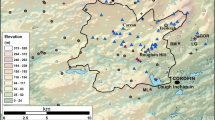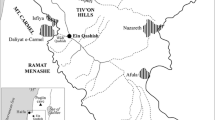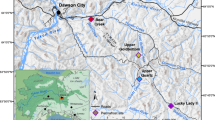Abstract
The twentieth-century excavations of stratified deposits at Kom W, adjacent to Lake Qarun in Fayum north shore, Egypt, led to a variety of interpretations, including the argument for the presence of a Neolithic village. This has influenced the evaluation of early to mid-Holocene occupation in Egypt. Here, we report our recent study of the erosion and deposition processes at the site and its environs in order to reassess these interpretations. Changes in the level of Lake Qarun, evidence for wind erosion, deflation, and deposition, and analyses of artifact density provide a geomorphic context for Kom W and its immediate environs. Radiocarbon determinations from surface hearths that surround the Kom are reported. From the time of its initial formation, Kom W was subject to post-depositional processes, particularly wind erosion, which have affected the site’s current form, and the preservation of features and artifact within the deposits. These changes need to be considered when deriving behavioral interpretations from the archaeological record at Kom W and in the surrounding area. The composition of deflated deposits that surround Kom W suggests that the site is not as unique as once imagined. Remains that might have allowed interpretations of a village occupation have not survived. Instead, deposits are consistent with other early to mid-Holocene occupations interpreted as locations with the use of domesticates but without villages.
Résumé
Les fouilles du XXe siècle des dépôts stratifiés de Kom W, adjacent au lac Qarun sur la rive nord du Fayoum, en Égypte, ont donné lieu à diverses interprétations. Notre récente étude des processus d’érosion et de dépôt sur le site et ses environs, dont il est question ici, permet de réévaluer ces interprétations. Les changements de niveau du lac Qarun, les preuves d’érosion éolienne, de déflation et de dépôt, et les analyses de la densité des artefacts fournissent un contexte géomorphique pour le Kom W et ses environs immédiats. On rapporte des déterminations de radiocarbone dans les foyers de surface qui entourent le Kom. Depuis sa formation initiale, le Kom W a été soumis à des processus post-dépôt, en particulier l’érosion éolienne, qui ont affecté la forme actuelle du site, et la préservation des caractéristiques et des artefacts dans les dépôts. Ces changements doivent être pris en compte lors de l’interprétation du comportement des vestiges archéologiques du Kom W et de ses environs. La composition des dépôts dégonflés qui entourent le Kom W suggère que le kom n’est. pas aussi unique qu’on l’avait imaginé. Les vestiges qui auraient pu permettre des interprétations de l’occupation d’un village n’ont pas survécu. Au contraire, les dépôts correspondent à d’autres occupations du début et du milieu de l’Holocène interprétées comme des lieu où l’on utilise des domestiques sans village.







Similar content being viewed by others
References
Ball, J. (1939). Contributions to the geography of Egypt. Bulaq: Government Press.
Braidwood, R. (1958). Near eastern prehistory. Science, 127(3312), 1419–1430. https://doi.org/10.1126/science.127.3312.1419.
Braidwood, R. (1960). The agricultural revolution. San Francisco: W. H. Freeman.
Brookes, I. A. (2003). Geomorphic indicators of Holocene winds in Egypt’s Western Desert. Geomorphology, 56(1), 155–166. https://doi.org/10.1016/S0169-555X(03)00076-X.
Caton-Thompson, G., & Gardner, E. W. (1934). The desert Fayum. London: The Royal Anthropological Institute of Great Britian and Ireland.
Childe, V. G. (1956). Man makes himself. London: Watts & Co..
El-Baz, F. (1986). Monitoring the sand-moving desert winds. In F. El-Baz & M. H. A. Hassan (Eds.), Physics of desertification (pp. 141–158). Dordrecht: Springer Netherlands.
El-Baz, F., & Wolfe, R. W. (1982). Wind patterns in the Western Desert. In F. El-Baz & T. A. Maxwell (Eds.), Desert landforms of Southwest Egypt: A basis for comparison with Mars (pp. 119–139). Washington, D.C.: NASA Scientific and Technical Information Branch.
Emmitt, J. J. (2011). Investigating ceramics from the Neolithic occupation of Kom W, Fayum, Egypt. Unpublished Masters thesis, University of Auckland. https://doi.org/10.13140/RG.2.1.1247.0166
Emmitt, J. J. (2017) The Neolithic pottery of Egypt: Investigating settlement pattern in middle Holocene northeast Africa with ceramics. PhD dissertation, University of Auckland, Auckland, New Zealand. https://doi.org/10.13140/RG.2.2.12527.33445.
Emmitt, J. J. (2019). Formation and function: Middle Holocene pottery from Kom W, Fayum, Egypt. Quaternary International. https://doi.org/10.1016/j.quaint.2019.09.032.
Emmitt, J. J., Sefton, B., Phillipps, R. S., Wendrich, W., & Holdaway, S. J. (2017). Reimag (in) ing the past: Adding the third dimension to archaeological section drawings. Advances in Archaeological Practice, 5(1), 44–53. https://doi.org/10.1017/aap.2016.5.
Flower, R. J., Keatings, K., Hamdan, M., Hassan, F. A., Boyle, J. F., Yamada, K., & Yasuda, Y. (2012). The structure and significance of early Holocene laminated lake sediments in the Faiyum depression (Egypt) with special reference to diatoms. Diatom Research, 27(3), 127–140. https://doi.org/10.1080/0269249X.2012.703624.
Fryberger, S. C. (1979). Dune forms and wind regime. In E. D. McKee (Ed.), A Study of Global Sand Seas, Geological Survey Professional Paper, 1052 (pp. 137–169). Washington, D. C: United States Geological Survey.
Gardner, E. W., & Caton-Thompson, G. (1926). The recent geology and Neolithic industry of the Northern Fayum Desert. The Journal of the Royal Anthropological Institute of Great Britain and Ireland, 56, 301–323. https://doi.org/10.2307/2843614.
Glennie, K. W. (2005). The desert of Southeast Arabia. Bahrain: Gulf PetroLink.
Goldberg, P., & Macphail, R. I. (2006). Practical and theoretical geoarchaeology. Malden: Blackwell Science.
Hassan, F. A. (1986). Holocene lakes and prehistoric settlements of the Western Faiyum, Egypt. Journal of Archaeological Science, 13(5), 483–501. https://doi.org/10.1016/0305-4403(86)90018-X.
Hereher, M. E. (2010). Sand movement patterns in the Western Desert of Egypt: An environmental concern. Environmental Earth Sciences, 59(5), 1119–1127. https://doi.org/10.1007/s12665-009-0102-9.
Holdaway, S. J., & Wendrich, W. (Eds.). (2017). The Desert Fayum reinvestigated: The early to mid-Holocene landscape archaeology of the Fayum North Shore, Egypt. Los Angeles: Cotsen Institute of Archaeology Press.
Holdaway, S. J., Phillipps, R. S., Emmitt, J. J., & Wendrich, W. (2016). The Fayum revisited: Reconsidering the role of the Neolithic package, Fayum north shore, Egypt. Quaternary International, 410(A), 173–180. https://doi.org/10.1016/j.quaint.2015.11.072.
Koopman, A. (2008). Landscape reconstruction around Neolithic Kom W. Fayum, Egypt: A geo-archaeological approach. (IGBA Rapport 2008-07). Amsterdam: Instituut voor Geo- en Bio-archeologie, Vrije Universiteit..
Koopman, A., Kluiving, S., Holdaway, S. J., & Wendrich, W. (2016). The effects of Holocene landscape changes on the formation of the archaeological record in the Fayum Basin, Egypt. Geoarchaeology: An International Journal, 31(1), 17–33. https://doi.org/10.1002/gea.21538.
Kozlowski, J. K., & Ginter, B. (1993). Holocene changes in the Fayum: Lake Moeris and the evolution of climate in North-Eastern Africa. In L. Krzyżaniak, M. Kobusiewicz, & J. Alexander (Eds.), Environmental change and human culture in the Nile Basin and Northern Africa until the second millennium B.C (pp. 327–336). Poznań: Poznań Archaeological Museum.
Linseele, V., Van Neer, W., Thys, S., Phillipps, R., Cappers, R., Wendrich, W., & Holdaway, S. (2014). New archaeozoological data from the Fayum “Neolithic” with a critical assessment of the evidence for early stock keeping in Egypt. PLoS One, 9(10), e108517. https://doi.org/10.1371/journal.pone.0108517.
Marks, L., Salem, A., Welc, F., Nitychoruk, J., Chen, Z., Zalat, A., Majecka, A., Chodyka, M., Szymanek, M., & Tołoczko-Pasek, A. (2016). Preliminary report on unique laminated Holocene sediments from the Qarun Lake in Egypt. Studia Quaternaria, 33(1), 35–46. https://doi.org/10.1515/squa-2016-0004.
Marks, L., Salem, A., Welc, F., Nitychoruk, J., Chen, Z., Blaauw, M., Zalat, A., Majecka, A., Szymanek, M., Chodyka, M., Tołoczko-Pasek, A., Sun, Q., Zhao, X., & Jiang, J. (2018). Holocene lake sediments from the Faiyum Oasis in Egypt: A record of environmental and climate change. Boreas, 47(1), 62–79. https://doi.org/10.1111/bor.12251.
Nichols, G. (2006). Sedimentology and stratigraphy. Oxford: Blackwell Science.
Phillipps, R. S. (2012). Documenting socio-economic variability in the Egyptian Neolithic through stone artefact analysis. Unpublished PhD dissertation, The University of Auckland, Auckland.
Phillipps, R. S., & Holdaway, S. J. (2016). Estimating core number in assemblages: Core movement and mobility during the Holocene of the Fayum, Egypt. Journal of Archaeological Method and Theory, 23(2), 520–540. https://doi.org/10.1007/s10816-015-9250-2.
Phillipps, R. S., Holdaway, S. J., Wendrich, W., & Cappers, R. T. J. (2012). Mid-Holocene occupation of Egypt and global climatic change. Quaternary International, 251, 64–76. https://doi.org/10.1016/j.quaint.2011.04.004.
Phillipps, R. S., Holdaway, S. J., Emmitt, J. J., & Wendrich, W. (2016a). Variability in the Neolithic settlement patterns of the Egyptian Nile Valley. African Archaeological Review, 33(3), 277–295. https://doi.org/10.1007/s10437-016-9224-0.
Phillipps, R. S., Holdaway, S. J., Ramsay, R., Emmitt, J. J., Wendrich, W., & Linseele, V. (2016b). Lake level changes, lake edge basins and the paleoenvironment of the Fayum North Shore, Egypt, during the Early to Mid-Holocene. Open Quaternary, 2(2), 1–12. https://doi.org/10.5334/oq.19.
Phillipps, R. S., Holdaway, S. J., Ramsay, R., Wendrich, W., & Emmitt, J. J. (2017). Approaches to paleoenvironment and landscape use. In S. J. Holdaway & W. Wendrich (Eds.), The Desert Fayum reinvestigated: The early to mid-Holocene landscape archaeology of the Fayum North Shore, Egypt (pp. 17–49). Los Angeles: Cotsen Institute of Archaeology Press.
Sandford, K. S., & Arkell, A. J. (1929). Paleolithic man and the Nile-Faiyum divide: A study of the region during Pliocene and Pleistocene times. Chicago: The University of Chicago Oriental Institute Publications.
Shirai, N. (2016). The Desert Fayum at 80: Revisiting a Neolithic farming community in Egypt. Antiquity, 90(353), 1181–1195. https://doi.org/10.15184/aqy.2016.133.
Stuiver, M., & Polach, H. A. (1977). Discussion reporting of 14C data. Radiocarbon, 19(3), 355–363. https://doi.org/10.1017/S0033822200003672.
Villing, A. (2013). Reconstructing a 19th-century excavation: Problems and perspectives. In A. Villing, M. Bergeron, G. Bourogiannis, A. Johnston, F. Leclère, A. Masson & R. Thomas (Eds.), Naukratis: Greeks in Egypt. British Museum Online Research Catalogue, 2013-2015.
Wendorf, F., & Schild, R. (1976). Prehistory of the Nile Valley. New York: Academic.
Wendrich, W., Taylor, R. E., & Southon, J. (2010). Dating stratified settlement sites at Kom K and Kom W: Fifth millennium BCE radiocarbon ages for the Fayum Neolithic. Nuclear Instruments and Methods in Physics Research Section B: Beam Interactions with Materials and Atoms, 268(7–8), 999–1002. https://doi.org/10.1016/j.nimb.2009.10.083.
Wengrow, D. (2006). The archaeology of Early Egypt: Social transformations in North-East Africa, 10,000 to 2650 BC. Cambridge: Cambridge University Press.
Wolfe, R. W., & El-Baz, F. (1979). The wind regime of the Western Desert of Egypt. (NASA Tech. Memo. 80339).
Zeder, M. A. (2009). The Neolithic macro-(r)evolution: Macroevolutionary theory and the study of culture change. Journal of Archaeological Research, 17(1), 1–63. https://doi.org/10.1007/s10814-008-9025-3.
Acknowledgements
The Egyptian Supreme Council of Antiquities and the Ministry of State for Antiquities (MSA) granted permission to work on the Fayum material to the University of California Los Angeles, Groningen University, University of Auckland Fayum Project (URU). We also wish to thank G. Lucarini and J. Linstädter for the invitation to present in the UISPP session in Paris and to contribute to this volume. Seline McNamee prepared Fig. 5. Thanks to Alice Leplongeon for assisting with the translation of the French abstract.
Funding
This study was supported by the Royal Society of New Zealand through a Marsden grant (UOA1106), by the National Geographic Society (8293-07, 8295-07, 8413-08), and by the University of Auckland.
Author information
Authors and Affiliations
Corresponding author
Ethics declarations
Conflict of Interest and Ethical Statement
The authors declare that they have no conflict of interest.
Ethical Statement
This article does not contain any studies with animals performed by any of the authors.
Additional information
Publisher’s Note
Springer Nature remains neutral with regard to jurisdictional claims in published maps and institutional affiliations.
Rights and permissions
About this article
Cite this article
Emmitt, J., Phillipps, R., Koopman, A. et al. Kom W and X Basin: Erosion, Deposition, and the Potential for Village Occupation. Afr Archaeol Rev 38, 95–111 (2021). https://doi.org/10.1007/s10437-020-09370-1
Published:
Issue Date:
DOI: https://doi.org/10.1007/s10437-020-09370-1




